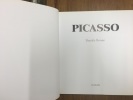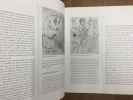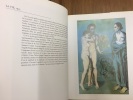Danièle Boone
Picasso
Hazan, Les Chefs-d'Oeuvre, 1988. In-4, relié, toilé éditeur bleu pétrole sous jaquette illustrée, 138 pages. Nombreuses photographies et reproductions n&b et couleurs. Ex-libris manuscrit. Texte sur deux colonnes. Jaquette légèrement tachée, tranches jaunie. Léger enfoncement sur tranche de queue. Dos et couverture bons. Intérieur frais. Bon exemplaire
Reference : ART6849M
Bookseller's contact details
Librairie du Levant
M. Yannick RENAUD
15 rue Marengo
64100 Bayonne
France
+33 5 59 03 69 40
Payment mode




Sale conditions
We accept payments in € by bank transfers, remote Credit Card, Paypal or checks. Checks made payable to and addressed to: Librairie du Levant 15 rue Marengo 64100 Bayonne France Bank transfers to: Banque Courtois, 1 pl du Réduit 64100 Bayonne / RIB / 10268 02696 62711600200 13 / IBAN / FR76 1026 8026 9662 7116 0020 013 / SWIFT BIC / COURFR2T PAYPAL via the address: librairiedulevant@orange.fr For any remote payment by Credit Card, informations communicated are automatically deleted as soon as payment is made and validated. Shipping upon receipt of payment. Member of the Syndicat des Libraires Anciens et Modernes (SLAM) and of the International League of Antiquarian Booksellers (ILAB), our sales are made according to the customs of the profession. All our books and objetcs are guaranteed to conform to the description which appears in each sheet; if, as a result of an error or an oversight, this was not the case, order will be taken back (within fifteen days) and reimbursed (including the costs of redirection), provided that it is returned in the same condition as the purchase. For obvious technical reasons (format, colors, cropping, viewing angle, etc.), the photographs presented on this site are not contractual. Our prices are in Euros, packaging included. Shipments, made under the responsibility of the buyers, are made by Colissimo Post, registered with insured value from € 50 and up to € 5,000 (delivery against signature, package tracking and insured value); for works less than 50 €, shipments are made by registered letter; works whose value exceeds € 5,000 must be sent by special carrier with insured value and delivery against signature. For any shipment outside mainland France, shipping and insurance costs remain the responsibility of the customer. Shipments are made under the same conditions set out above. Possibility to collect the orders on site. Do not hesitate to keep up to date with our news, finds, curiosities, catalogs and various thematic lists by leaving your contact details by email at librairiedulevant@orange.fr
5 book(s) with the same title
( Beaux-Arts ) - Louis Aragon - Gyula Halász dit Brassaï - Pablo Picasso.
Reference : 8422
(1960)
Pablo Picasso. Sculptures. Dessins.
Editions Maison de la Pensée Française 1950. In-8 broché de 34 pages au format 22 x 16 cm. Couverture avec illustration de Pablo Picasso et photographie de Brassaï. Dos carré, muet, légèrement insolé. Plats avec bords un peu brunis. Intérieur frais. Préface de Louis Aragon. Catalogue d'exposition avec reproductions d'illustrations en noir de Pablo Picasso, ainsi que des photographies de Gyula Halász dit Brassaï et de la galerie Louise Leiris. Rare édition originale en bel état général.
Site Internet : Http://librairie-victor-sevilla.fr.Vente exclusivement par correspondance. Le libraire ne reçoit, exceptionnellement que sur rendez-vous. Il est préférable de téléphoner avant tout déplacement.Forfait de port pour un livre 7 €, sauf si épaisseur supérieure à 3 cm ou valeur supérieure ou égale à 100 €, dans ce cas expédition obligatoire au tarif Colissimo en vigueur. A partir de 2 livres envoi en colissimo obligatoire. Port à la charge de l'acheteur pour le reste du monde.Les Chèques ne sont plus acceptés.Pour destinations extra-planétaire s'adresser à la NASA.Membre du Syndicat Lusitanien Amateurs Morues
( Beaux arts ) - Pablo Picasso - Jean Cocteau - Paul Léautaud - Jacques Prévert - Paul-Emile Victor - Collectif.
Reference : 29832
(1956)
Les Peintres témoins de leur temps V : Réhabilitation du Portrait. ( Couverture par Pablo Picasso, tirée en lithographie par Mourlot ).
Les Peintres Témoins de leur Temps / Musée Galliera 1956. In-8 cartonnage éditeur de 320 pages au format 21 x 13,5 cm. Superbe jaquette rempliée illustrée par Picasso ( Portrait de Mme Z ) tirée en lithographie par Mourlot frères sur arches. Dos carré avec petites traces brunes. 4ème plat avec traces brunes. Intérieur frais, tiré sur couché. Nombreux facs-similés de lettres, autographes d'écrivains et personnalités avec portrait photo inédits ( Paul Léautaud, Jean Cocteau, René Clair, Abbé Pierre, André Maurois, Gaston Bachelard, Charlie Chaplin , Christian Dior, Jacques Prévert, Albert Camus, Picasso, Louis Armstrong, etc ) avec en regard photos et illustrations de très nombreux artistes ( Ambrogiani, Bezombes, Brayer, Berthommé-Saint-André, Jean Cocteau, Pablo Picasso, Bernard Buffet, Carzou, Ciry, Foujita, Gimond, Labisse, Constant Le Breton, Masereel, Sarthou, Van Dongen etc...). Edition originale en assez bel état général.
Site Internet : Http://librairie-victor-sevilla.fr.Vente exclusivement par correspondance. Le libraire ne reçoit, exceptionnellement que sur rendez-vous. Il est préférable de téléphoner avant tout déplacement.Forfait de port pour un livre 7 €, sauf si épaisseur supérieure à 3 cm ou valeur supérieure ou égale à 100 €, dans ce cas expédition obligatoire au tarif Colissimo en vigueur. A partir de 2 livres envoi en colissimo obligatoire. Port à la charge de l'acheteur pour le reste du monde.Les Chèques ne sont plus acceptés.Pour destinations extra-planétaire s'adresser à la NASA.Membre du Syndicat Lusitanien Amateurs Morues
( Disques - Pablo Picasso ) - André Verdet et Le Groupe Bételgeuse.
Reference : 29130
(1950)
Picasso Blues - Poèmes.( Disque 33 tours ).
Editions Sapem – SAP 300 sans date ( 1980 ). Disque vinyle LP 33 tours dépliant avec couvertures et dessins intérieurs par André Verdet. Coins et dos avec petits frottis et tassements. Disque lui en superbe état. Poèmes écrits et dits par André Verdet en hommage à Picasso, sur une musique pop/rock interprété par le Groupe Bételgeuse, formé de Gérard Guérin à la basse, A. Ruard à la batterie, Gilbert Trem aux guitares, Jean-Baptiste Bussonera aux claviers, Frédéric Altmann, narration. Edition originale. Rare.
Site Internet : Http://librairie-victor-sevilla.fr.Vente exclusivement par correspondance. Le libraire ne reçoit, exceptionnellement que sur rendez-vous. Il est préférable de téléphoner avant tout déplacement.Forfait de port pour un livre 7 €, sauf si épaisseur supérieure à 3 cm ou valeur supérieure ou égale à 100 €, dans ce cas expédition obligatoire au tarif Colissimo en vigueur. A partir de 2 livres envoi en colissimo obligatoire. Port à la charge de l'acheteur pour le reste du monde.Les Chèques ne sont plus acceptés.Pour destinations extra-planétaire s'adresser à la NASA.Membre du Syndicat Lusitanien Amateurs Morues
L'Homme au Mouton de Pablo Picasso. ( Dédicacé par Yves Montand, Simone Signoret, André Verdet et un inconnu )
Editions Falaize 1950. In-12 broché de 24 pages au format 12 x 15,5 cm. Couverture illustrée par une photo. Dos carré avec des frottis, comme sur les mors. Coins avec infimes frottis et tassement. Texte / poème dit par André Verdet le 6 Août 1950 à Vallauris, lors de l'inauguration de la sculpture de " l'Homme au Mouton " de Pablo Picasso. Contient 22 planches de photographies de Lionel Prejger. Bel état général. Edition originale. Rare exemplaire orné dune dédicace commune de André Verdet, Yves Montand, Simone Signoret et d'une autre personnalitée ( non reconnue ).
Site Internet : Http://librairie-victor-sevilla.fr.Vente exclusivement par correspondance. Le libraire ne reçoit, exceptionnellement que sur rendez-vous. Il est préférable de téléphoner avant tout déplacement.Forfait de port pour un livre 7 €, sauf si épaisseur supérieure à 3 cm ou valeur supérieure ou égale à 100 €, dans ce cas expédition obligatoire au tarif Colissimo en vigueur. A partir de 2 livres envoi en colissimo obligatoire. Port à la charge de l'acheteur pour le reste du monde.Les Chèques ne sont plus acceptés.Pour destinations extra-planétaire s'adresser à la NASA.Membre du Syndicat Lusitanien Amateurs Morues
( Bandes Dessinées - Bibliographie ) - Anonyme - Frank Margerin - Jean-Claude Mézières - Cathy Millet - Chantal Montellier - Jean-Michel Nicollet - Gilles Nicoulaud - René Pétillon - Loulou Picasso - Georges Pichard - Gérald Poussin - Jean-Marc Reiser - Jean-Marc Rochette.
Reference : 7041
(1981)
Dossier avec courte biographie, bibliographie et photographie en noir sur : Frank Margerin, Jean-Claude Mézières, Cathy Millet, Chantal Montellier, Jean-Michel Nicollet, Gilles Nicoulaud, René Pétillon, Loulou Picasso, Georges Pichard, Gérald Poussin, Jean-Marc Reiser, Jean-Marc Rochette.
Sans mention d'éditeur, ni de date ( 1981 ). In-8 agrafé, carré, de 24 pages au format 26 x 26 cm. Couvertures muettes, noires. Plats et intérieur frais. Contient une courte biographie et bibliographie qui s'arrête en 1981, avec photographie en noir et parfois reproduction en facsimilé de la signature de Frank Margerin, Jean-Claude Mézières, Cathy Millet, Chantal Montellier, Jean-Michel Nicollet, Gilles Nicoulaud, René Pétillon, Loulou Picasso, Georges Pichard, Gérald Poussin, Jean-Marc Reiser, Jean-Marc Rochette. Très bel état général. Edition originale.
Site Internet : Http://librairie-victor-sevilla.fr.Vente exclusivement par correspondance. Le libraire ne reçoit, exceptionnellement que sur rendez-vous. Il est préférable de téléphoner avant tout déplacement.Forfait de port pour un livre 7 €, sauf si épaisseur supérieure à 3 cm ou valeur supérieure ou égale à 100 €, dans ce cas expédition obligatoire au tarif Colissimo en vigueur. A partir de 2 livres envoi en colissimo obligatoire. Port à la charge de l'acheteur pour le reste du monde.Les Chèques ne sont plus acceptés.Pour destinations extra-planétaire s'adresser à la NASA.Membre du Syndicat Lusitanien Amateurs Morues
 Write to the booksellers
Write to the booksellers




